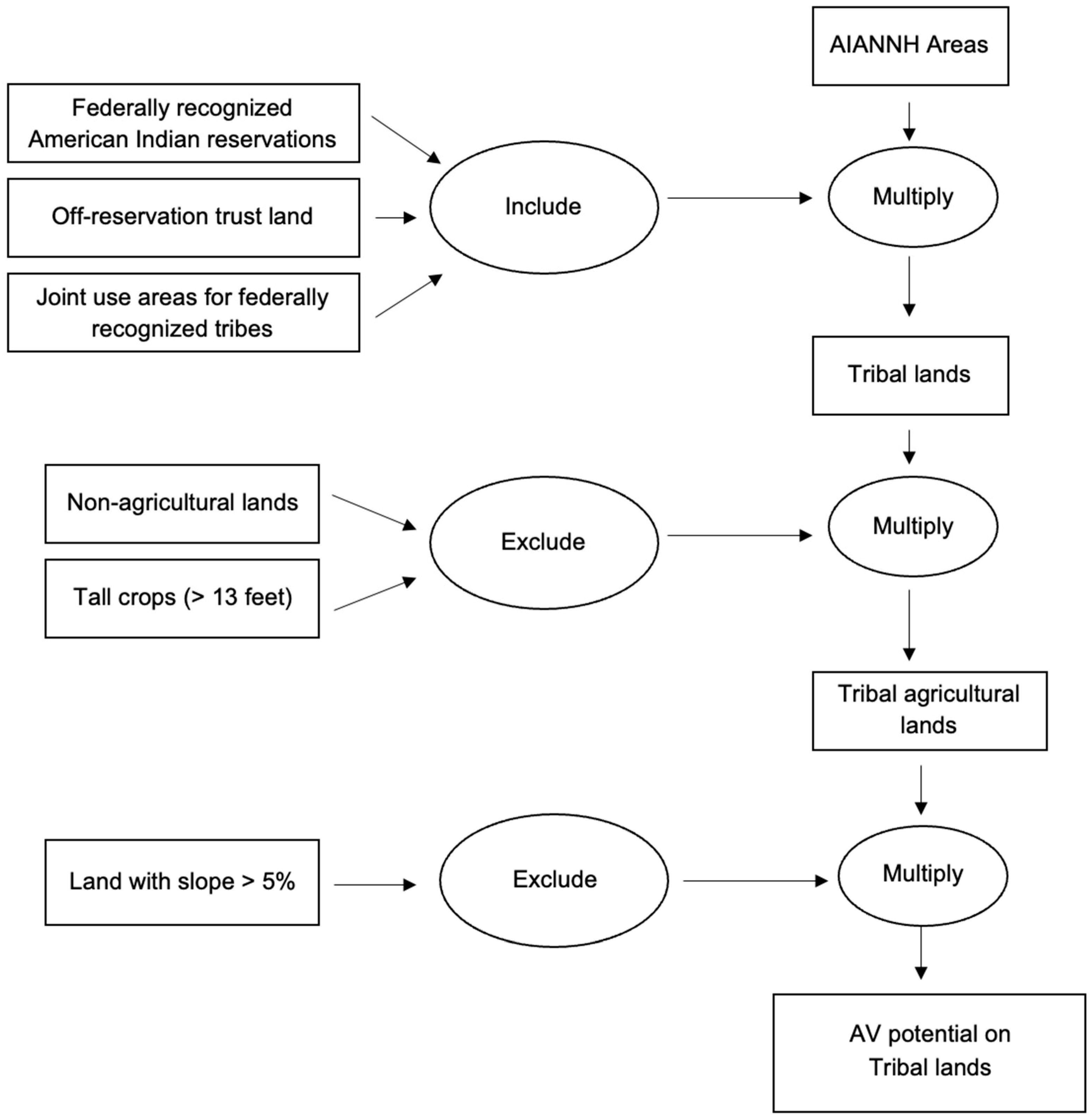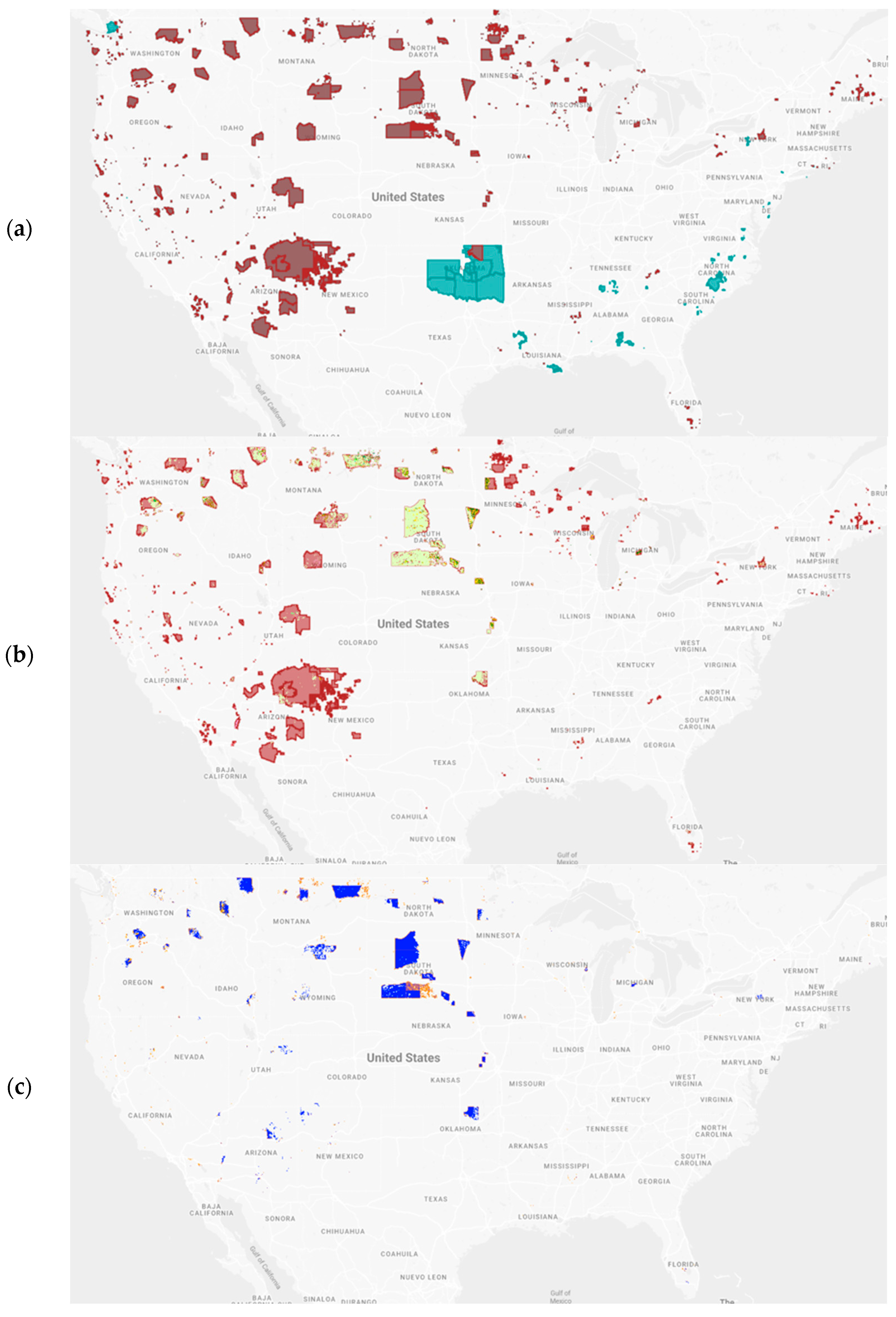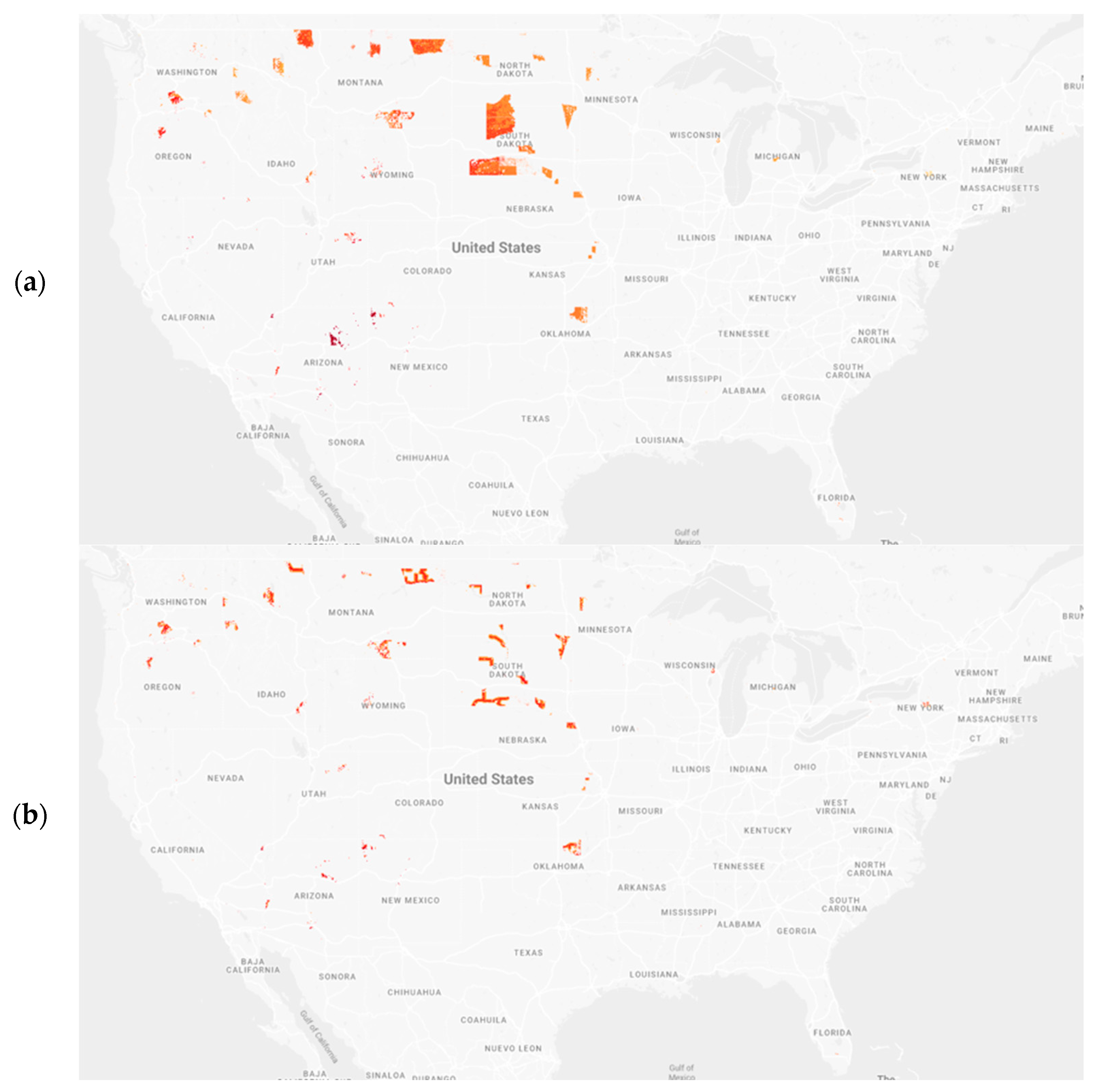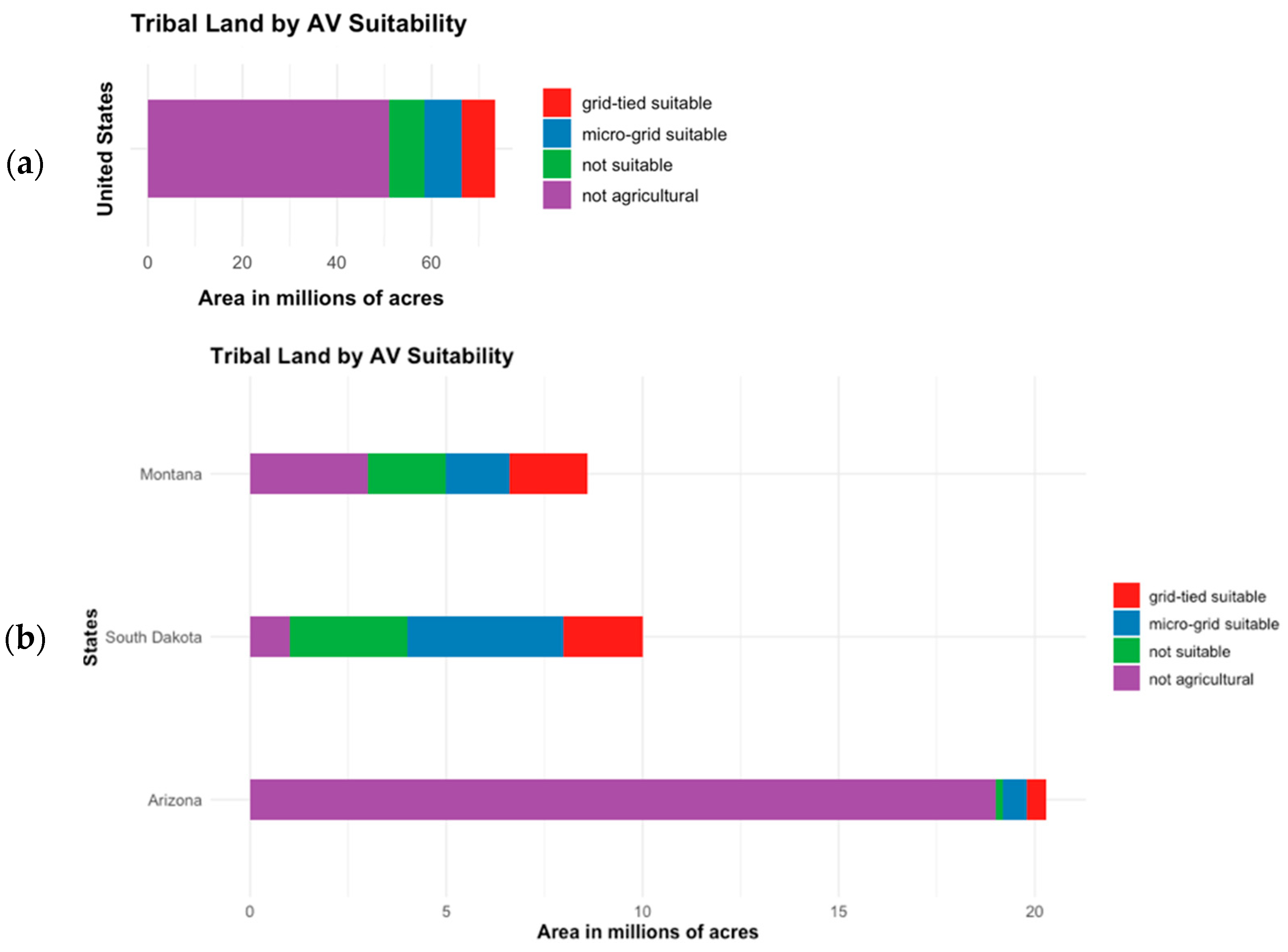Opportunities and Barriers for Agrivoltaics on Tribal Lands
Abstract
:1. Introduction
2. Materials and Methods
2.1. Scoping Study
2.2. Qualitative Data Collection and Analysis
2.3. Suitability Study
3. Results
3.1. Scoping Study Findings
3.2. Interview Findings: Opportunities for Adoption
3.2.1. Food Sovereignty Benefits
3.2.2. Energy Sovereignty Benefits
3.2.3. Economic Development Benefits
3.3. Interview Findings: Barriers to Adoption
3.3.1. Technical Concerns
3.3.2. Economic Concerns
3.3.3. Siting Concerns
3.3.4. Social-Ecological Concerns
3.4. Suitability Study Findings
4. Discussion
Limitations
5. Conclusions
Author Contributions
Funding
Institutional Review Board Statement
Informed Consent Statement
Data Availability Statement
Acknowledgments
Conflicts of Interest
Appendix A
Initial Interview Protocol
- Can you tell me about the first time you thought about pursuing a career in Native agriculture?
- How did you come to be in your current role? [If you’re not currently working in agriculture, how did you come to be in your most recent ag-related role?]
- a.
- How do you describe your role as a _____________?
- b.
- What areas of knowledge or skills are most crucial in your role?
- What areas do you consider to be your region of expertise?
- a.
- What type of agricultural production is found there?
- In your experience, what kind of energy production happens in your region?
- In what ways, if any, do you see agriculture and energy interacting in Tribal communities you are familiar with?
- a.
- How about agriculture interactions with solar energy in particular?
- b.
- What about positive or negative interactions?
- Have you seen any electricity issues in Tribal communities you are familiar with?
- As a quick pulse read, on a scale of 1–5 (with 1 being never heard of it before this study and 5 being very familiar), how familiar are you with agrivoltaics?
- a.
- If familiar, how did you hear about agrivoltaics?
- b.
- When you heard about it, was it in a positive, negative, or neutral context?
- From what you know about agrivoltaics:
- a.
- What is your initial reaction?
- b.
- Does it seem like agrivoltaics could be feasible in your community?
- c.
- How do you think the larger community reacts to the concept?
- d.
- If someone were interested in adopting agrivoltaics, what concerns or challenges do you think they might face?
- What impact might agrivoltaics have on:
- a.
- the productivity of the farm?
- b.
- the environment and/or wildlife?
- c.
- economic development in the area?
- d.
- food access in the area?
- e.
- energy access in the area?
- What are your initial thoughts (including questions you may have) about the scoping analysis map?
- a.
- How does the suitability calculated for your area resonate with your understanding and experience?
- b.
- What factors would you add or change?
- If a Tribal leader called you tomorrow asking for your opinion on agrivoltaics and you only had one minute to think, what would you tell them?
References
- White House. Inflation Reduction Act Guidebook|Clean Energy; White House: Washington, DC, USA, 2023. Available online: https://www.whitehouse.gov/cleanenergy/inflation-reduction-act-guidebook/ (accessed on 30 March 2024).
- White House. Funding for Tribes in the Inflation Reduction Act|Clean Energy; White House: Washington, DC, USA, 2023. Available online: https://www.whitehouse.gov/cleanenergy/tribes/ (accessed on 30 March 2024).
- Doris, E.; Lopez, A.; Beckley, D. Geospatial Analysis of Renewable Energy Technical Potential on Tribal Lands; National Renewable Energy Laboratory: Golden, CO, USA, 2013. Available online: https://www.nrel.gov/docs/fy13osti/56641.pdf (accessed on 30 March 2024).
- Yazzie, K.C.; Whyte, K.; Begay, S.; Glavin, J.; Jones, T.; Leni-Konig, K.; Pratte, C.; Madden, D.; Reicher, D.; Field, C.B. Opportunities to grow tribal clean energy in the US. Science 2024, 384, 163–165. [Google Scholar] [CrossRef] [PubMed]
- U.S. Department of Energy (DOE). SunShot Vision Study. 2012. Available online: https://www.energy.gov/sites/prod/files/2014/01/f7/47927.pdf (accessed on 30 March 2024).
- Adeh, E.H.; Good, S.P.; Calaf, M.; Higgins, C.W. Solar PV Power Potential Is Greatest Over Croplands. Sci. Rep. 2019, 9, 11442. [Google Scholar] [CrossRef] [PubMed]
- Hoffacker, M.K.; Allen, M.F.; Hernandez, R.R. Land-Sparing Opportunities for Solar Energy Development in Agricultural Landscapes: A Case Study of the Great Central Valley, CA, United States. Environ. Sci. Technol. 2017, 51, 14472–14482. [Google Scholar] [CrossRef] [PubMed]
- Dupraz, C.; Marrou, H.; Talbot, G.; Dufour, L.; Nogier, A.; Ferard, Y. Combining Solar Photovoltaic Panels and Food Crops for Optimising Land Use: Towards New Agrivoltaic Schemes. Renew. Energy 2011, 36, 2725–2732. [Google Scholar] [CrossRef]
- Barron-Gafford, G.A.; Pavao-Zuckerman, M.A.; Minor, R.L.; Sutter, L.F.; Barnett-Moreno, I.; Blackett, D.T.; Thompson, M.; Dimond, K.; Gerlak, A.K.; Nabhan, G.P.; et al. Agrivoltaics provide mutual benefits across the food–energy–water nexus in drylands. Nat. Sustain. 2019, 2, 848–855. [Google Scholar] [CrossRef]
- Marrou, H.; Dufour, L.; Wery, J. How does a shelter of solar panels influence water flows in a soil–crop system? Eur. J. Agron. 2013, 50, 38–51. [Google Scholar] [CrossRef]
- Trommsdorff, M.; Kang, J.; Reise, C.; Schindele, S.; Bopp, G.; Ehmann, A.; Weselek, A.; Högy, P.; Obergfell, T. Combining food and energy production: Design of an agrivoltaic system applied in arable and vegetable farming in Germany. Renew. Sustain. Energy Rev. 2021, 140, 110694. [Google Scholar] [CrossRef]
- Andrew, A.C. Lamb Growth and Pasture Production in Agrivoltaic Production System; Oregon State University: Corvallis, OR, USA, 2020. [Google Scholar]
- Lytle, W.; Meyer, T.K.; Tanikella, N.G.; Burnham, L.; Engel, J.; Schelly, C.; Pearce, J.M. Conceptual Design and Rationale for a New Agrivoltaics Concept: Pasture-Raised Rabbits and Solar Farming. J. Clean. Prod. 2020, 282, 124476. [Google Scholar] [CrossRef]
- Faria, A.F.P.A.; Maia, A.S.C.; Moura, G.A.B.; Fonsêca, V.F.C.; Nascimento, S.T.; Milan, H.F.M.; Gebremedhin, K.G. Use of Solar Panels for Shade for Holstein Heifers. Animals 2023, 13, 329. [Google Scholar] [CrossRef]
- Sacchelli, S.; Garegnani, G.; Geri, F.; Grilli, G.; Paletto, A.; Zambelli, P.; Ciolli, M.; Vettorato, D. Trade-off between photovoltaic systems installation and agricultural practices on arable lands: An environmental and socio-economic impact analysis for Italy. Land Use Policy 2016, 56, 90–99. [Google Scholar] [CrossRef]
- Marrou, H.; Guilioni, L.; Dufour, L.; Dupraz, C.; Wery, J. Microclimate under agrivoltaic systems: Is crop growth rate affected in the partial shade of solar panels? Agric. For. Meteorol. 2013, 177, 117–132. [Google Scholar] [CrossRef]
- Amaducci, S.; Yin, X.; Colauzzi, M. Agrivoltaic systems to optimise land use for electric energy production. Appl. Energy 2018, 220, 545–561. [Google Scholar] [CrossRef]
- Weselek, A.; Bauerle, A.; Hartung, J.; Zikeli, S.; Lewandowski, I.; Högy, P. Agrivoltaic system impacts on microclimate and yield of different crops within an organic crop rotation in a temperate climate. Agron. Sustain. Dev. 2021, 41, 59. [Google Scholar] [CrossRef]
- Gonocruz, R.A.; Nakamura, R.; Yoshino, K.; Homma, M.; Doi, T.; Yoshida, Y.; Tani, A. Analysis of the Rice Yield under an Agrivoltaic System: A Case Study in Japan. Environments 2021, 8, 65. [Google Scholar] [CrossRef]
- Max, T.; Vorast, M.; Durga, N.; Padwardhan, S. Potential of Agrivoltaics to Contribute to Socio-Economic Sustainability: A Case Study in Maharashtra/India. AIP Conf. Proc. 2021, 2361, 040001. [Google Scholar] [CrossRef]
- Ravi, S.; Macknick, J.; Lobell, D.; Field, C.; Ganesan, K.; Jain, R.; Elchinger, M.; Stoltenberg, B. Colocation opportunities for large solar infrastructures and agriculture in drylands. Appl. Energy 2016, 165, 383–392. [Google Scholar] [CrossRef]
- Marrou, H.; Wery, J.; Dufour, L.; Dupraz, C. Productivity and radiation use efficiency of lettuces grown in the partial shade of photovoltaic panels. Eur. J. Agron. 2013, 44, 54–66. [Google Scholar] [CrossRef]
- Al-Agele, H.A.; Proctor, K.; Murthy, G.; Higgins, C. A Case Study of Tomato (Solanum lycopersicon var. Legend) Production and Water Productivity in Agrivoltaic Systems. Sustainability 2021, 13, 2850. [Google Scholar] [CrossRef]
- Malu, P.R.; Sharma, U.S.; Pearce, J.M. Agrivoltaic potential on grape farms in India. Sustain. Energy Technol. Assess. 2017, 23, 104–110. [Google Scholar] [CrossRef]
- Al Mamun, M.A.; Dargusch, P.; Wadley, D.; Zulkarnain, N.A.; Aziz, A.A. A review of research on agrivoltaic systems. Renew. Sustain. Energy Rev. 2022, 161, 112351. [Google Scholar] [CrossRef]
- Pascaris, A.S.; Schelly, C.; Pearce, J.M. A First Investigation of Agriculture Sector Perspectives on the Opportunities and Barriers for Agrivoltaics. Agronomy 2020, 10, 1885. [Google Scholar] [CrossRef]
- Pascaris, A.S.; Schelly, C.; Burnham, L.; Pearce, J.M. Integrating solar energy with agriculture: Industry perspectives on the market, community, and socio-political dimensions of agrivoltaics. Energy Res. Soc. Sci. 2021, 75, 102023. [Google Scholar] [CrossRef]
- Irie, N.; Kawahara, N.; Esteves, A.M. Sector-wide social impact scoping of agrivoltaic systems: A case study in Japan. Renew. Energy 2019, 139, 1463–1476. [Google Scholar] [CrossRef]
- Biggs, N.B.; Shivaram, R.; Lacarieri, E.A.; Varkey, K.; Hagan, D.; Young, H.; Lambin, E.F. Landowner decisions regarding utility-scale solar energy on working lands: A qualitative case study in California. Environ. Res. Commun. 2022, 4, 055010. [Google Scholar] [CrossRef]
- Stang, J. Solar-Powered Microfarm Is Washington’s First Agrivoltaics Project|Energy News Network. Energy News Network. 2022. Available online: https://energynews.us/2022/06/22/on-washingtons-colville-reservation-solar-powered-microfarm-looks-to-prove-model-to-boost-food-energy-sovereignty/ (accessed on 30 March 2024).
- Gorelick, N.; Hancher, M.; Dixon, M.; Ilyushchenko, S.; Thau, D.; Moore, R. Google Earth Engine: Planetary-scale geospatial analysis for everyone. Remote Sens. Environ. 2017, 202, 18–27. [Google Scholar] [CrossRef]
- Hernandez, R.R.; Hoffacker, M.K.; Field, C.B. Efficient use of land to meet sustainable energy needs. Nat. Clim. Chang. 2015, 5, 353–358. [Google Scholar] [CrossRef]
- Sandelowski, M. Using Qualitative Research. Qual. Heal. Res. 2004, 14, 1366–1386. [Google Scholar] [CrossRef]
- Knott, E.; Rao, A.H.; Summers, K.; Teeger, C. Interviews in the social sciences. Nat. Rev. Methods Prim. 2022, 2, 1–15. [Google Scholar] [CrossRef]
- Corbin, J.; Strauss, A. Basics of Qualitative Research (3rd ed.): Techniques and Procedures for Developing Grounded Theory; SAGE Publications, Inc.: Sauzend Oaks, CA, USA, 2008. [Google Scholar] [CrossRef]
- Willig, C. Introducing Qualitative Research in Psychology; McGraw-Hill Education: London, UK, 2013. [Google Scholar]
- Hansen, M.C.; Potapov, P.V.; Pickens, A.H.; Tyukavina, A.; Hernandez-Serna, A.; Zalles, V.; Turubanova, S.; Kommareddy, I.; Stehman, S.V.; Song, X.-P.; et al. Global land use extent and dispersion within natural land cover using Landsat data. Environ. Res. Lett. 2022, 17, 034050. [Google Scholar] [CrossRef]
- Reinermann, S.; Asam, S.; Kuenzer, C. Remote Sensing of Grassland Production and Management—A Review. Remote Sens. 2020, 12, 1949. [Google Scholar] [CrossRef]
- Energy Sector Management Assistance Program. Global Solar Atlas 2.0: Technical Report; World Bank Group: Washington, DC, USA, 2019; Available online: http://documents.worldbank.org/curated/en/529431592893043403/Global-Solar-Atlas-2-0-Technical-Report (accessed on 30 March 2024).
- Majumdar, D. Planning for the Energy Transition: Solar Photovoltaics in Arizona. Ph.D. Thesis, Arizona State University, Tempe, AZ, USA, 2018. Available online: https://www.proquest.com/docview/2154878428/abstract/FE0FCF5FBE9A414FPQ/1 (accessed on 30 March 2024).
- Andrew, A.C.; Higgins, C.W.; Smallman, M.A.; Graham, M.; Ates, S. Herbage Yield, Lamb Growth and Foraging Behavior in Agrivoltaic Production System. Front. Sustain. Food Syst. 2021, 5, 659175. Available online: https://www.frontiersin.org/articles/10.3389/fsufs.2021.659175 (accessed on 30 March 2024). [CrossRef]
- Begay, S.K.; Begay, S.K. Navajo residential solar energy access as a global model. Electr. J. 2018, 31, 9–15. [Google Scholar] [CrossRef]
- O’Connor, J.E.; Duda, J.J.; Grant, G.E. 1000 dams down and counting. Science 2015, 348, 496–497. [Google Scholar] [CrossRef]
- Mead, R.; Willey, R.W. The Concept of a ‘Land Equivalent Ratio’ and Advantages in Yields from Intercropping. Exp. Agric. 1980, 16, 217–228. [Google Scholar] [CrossRef]
- Mavani, D.D.; Chauhan, P.; Joshi, V. Beauty of Agrivoltaic System Regarding Double Utilization of Same Piece of Land for Generation of Electricity & Food Production. 2019. Available online: https://www.semanticscholar.org/paper/Beauty-of-Agrivoltaic-System-regarding-double-of-of-Mavani-Chauhan/aec1fd08684d7e7edb4ae06620389317eaba387a (accessed on 30 March 2024).
- Shoemaker, J.A. No Sticks in My Bundle: Rethinking the Indian Land Tenure Problem. Kans. Law Rev. 2014, 63, 383–450. [Google Scholar]
- Proctor, K.W.; Murthy, G.S.; Higgins, C.W. Agrivoltaics Align with Green New Deal Goals While Supporting Investment in the US’ Rural Economy. Sustainability 2021, 13, 137. [Google Scholar] [CrossRef]






| Parameter | Dataset |
|---|---|
| Tribal land base | US Census Bureau AIANNH Areas |
| Agricultural land use | USDA Cropland Data Layer |
| Slope | SRTM Digital Elevation Data V4 |
| Sector | Location | Gender | Age | Producer Status |
|---|---|---|---|---|
| Nonprofit: 15 | Eastern US: 3 | Female: 11 | 18–29: 7 | Current: 10 |
| Academia: 3 | Great Plains: 4 | Male: 10 | 30–49: 10 | Former: 2 |
| Private: 2 | Rocky Mountains: 3 | 50–69: 3 | Never: 9 | |
| Public: 1 | Southwest US: 6 | 70+: 1 | ||
| Pacific Coast: 5 |
| Area (1000 Acres) | % of Subtotal | ||
|---|---|---|---|
| Tribal agricultural area | Cropland | 6790 | 31% |
| Pastureland | 15,415 | 69% | |
| Subtotal | 22,205 | - | |
| Tribal agrivoltaics potential | Cropland | 5920 | 39% |
| Pastureland | 9297 | 61% | |
| Subtotal | 15,217 | - |
| Concern | Count |
|---|---|
| Technical | 15 |
| Economic | 19 |
| Siting | 18 |
| Socio-ecological | 15 |
| AV Feasible Land | |
| Top states | 100,000 acres |
| (1) South Dakota | 63.8 |
| (2) Montana | 33.8 |
| (3) Arizona | 10.9 |
| (4) North Dakota | 10.8 |
| (5) Oklahoma | 6.6 |
| (6) New Mexico | 4.5 |
| (7) Idaho | 3.0 |
| (8) Minnesota | 2.7 |
| (9) Washington | 2.6 |
| (10) Utah | 2.5 |
| Grid-tied AV feasible land | |
| Top states | 100,000 acres |
| (1) South Dakota | 23.1 |
| (2) Montana | 17.9 |
| (3) Arizona | 4.7 |
| (4) Oklahoma | 4.5 |
| (5) North Dakota | 4.1 |
| (6) New Mexico | 3.7 |
| (7) Washington | 2.3 |
| (8) Idaho | 2.0 |
| (9) Minnesota | 1.9 |
| (10) Nebraska | 1.6 |
| AV priority land | |
| Top states | 100,000 acres |
| (1) South Dakota | 29.0 |
| (2) Montana | 18.1 |
| (3) Arizona | 10.9 |
| (4) New Mexico | 4.5 |
| (5) Oklahoma | 3.5 |
| (6) Utah | 2.5 |
| (7) Wyoming | 1.8 |
| (8) Washington | 1.1 |
| (9) North Dakota | 1.0 |
| (10) Oregon | 0.9 |
| Grid-tied AV priority land | |
| Top states | 100,000 acres |
| (1) South Dakota | 11.1 |
| (2) Montana | 9.1 |
| (3) Arizona | 4.0 |
| (4) New Mexico | 3.5 |
| (5) Oklahoma | 2.4 |
| (6) Minnesota | 1.8 |
| (7) North Dakota | 1.5 |
| (8) Washington | 1.2 |
| (9) Idaho | 1.1 |
| (10) Utah | 1.0 |
| Theme | Findings | Sample Quote | Recommendation |
|---|---|---|---|
| Durability | Participants questioned the durability of AV infrastructure given various hazards on working lands. | “How tough is the agrivoltaics equipment? Because someone is totally backing a tractor into it at some point”. (P6) | Sponsor pilot projects to test AV infrastructure in a variety of production systems. |
| Complexity | Participants expressed concerns about increased knowledge and management burdens for producers. | “Your practices will have to adapt. Understanding what you can and can’t do versus having a wide-open piece of land is going to be a major thing”. (P2) | Scale up extension services to provide evidenced-based recommendations to producers. |
| Productivity | Participants worried that AV installations would hinder their land productivity. | “I would be worried that the rain isn’t going to hit parts of the field and the panels would cause runoff to pool into one spot”. (P15) | Invest in robust research programs to measure and mitigate impacts to productivity. |
| Financing | Participants anticipated challenges raising large sums of capital for AV given the socio-economic landscape in Tribal areas. | “I like the idea, but I think the upfront cost will turn a lot of people off. It’s really expensive to do solar”. (P16) | Explore opportunities to fund AV through existing set-asides for clean energy development on Tribal lands. |
| Market | Participants did not think utility companies would want to purchase energy from AV. | “You have all this excess energy, but who is going to buy it? Will the utility commission even allow us to sell surplus energy to other people?” (P10) | Consider incentives for utility companies to cooperate with AV operators in their service area. |
| Labor | Participants shared how the acute shortage of trained workers in Tribal areas could constrain AV implementation. | “We have a human resources capacity problem in Tribal areas”. (P13) | Develop comprehensive training material that can be delivered to interested parties in rural areas. |
| Land tenure | Participants saw land tenure complexities as a major hurdle for AV implementation. | “Land restrictions would probably be the number one issue that we would run up against”. (P2) | Partner with Tribes on proposals to streamline land use and development. |
| Leasing | Participants expected challenges implementing AV on land leased through the Bureau of Indian Affairs (BIA). | “It’s a big, big hurdle with BIA land management to put in infrastructure, or even just to generally operate”. (P6) | Direct resources to alleviate bureaucratic backlogs and increase responsiveness to Tribal clients. |
| People | Participants emphasized that potential AV projects would need to benefit the whole community, not just interested parties. | “What are the community’s likes, the community’s passions? How can it benefit the community beyond the money sense?” (P18) | Make space for stakeholder input and create a holistic framework for assessing community benefit. |
| Nature | Participants voiced concerns about the well-being of plants, animals and water in proximity to AV systems. | “How will wildlife be impacted by this? I feel like people don’t consider that many tribes are very respectful of all wildlife, even animals that may be thought of as vermin by others”. (P16) | Prioritize technology and design solutions that minimize disruption to the ecosystem. |
Disclaimer/Publisher’s Note: The statements, opinions and data contained in all publications are solely those of the individual author(s) and contributor(s) and not of MDPI and/or the editor(s). MDPI and/or the editor(s) disclaim responsibility for any injury to people or property resulting from any ideas, methods, instructions or products referred to in the content. |
© 2024 by the authors. Licensee MDPI, Basel, Switzerland. This article is an open access article distributed under the terms and conditions of the Creative Commons Attribution (CC BY) license (https://creativecommons.org/licenses/by/4.0/).
Share and Cite
Moore, K.A.; Lobell, D.B. Opportunities and Barriers for Agrivoltaics on Tribal Lands. Sustainability 2024, 16, 5414. https://doi.org/10.3390/su16135414
Moore KA, Lobell DB. Opportunities and Barriers for Agrivoltaics on Tribal Lands. Sustainability. 2024; 16(13):5414. https://doi.org/10.3390/su16135414
Chicago/Turabian StyleMoore, Karli A., and David B. Lobell. 2024. "Opportunities and Barriers for Agrivoltaics on Tribal Lands" Sustainability 16, no. 13: 5414. https://doi.org/10.3390/su16135414





